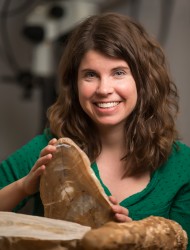Evidence suggests climate whiplash may have more extremes in store for California
Vanderbilt paleoclimatologists using pioneering research have uncovered evidence of ancient climate “whiplash” in California that exceeded even the extremes the state has weathered in the past decade. Their findings present a long-term picture of what regional climate change may look like in the state that supplies the U.S. with more than a third of its vegetables and two-thirds of its fruits and nuts.

“We hope this is useful to planners who are seeking more information on recurrence intervals of climate events like droughts, storms and floods,” said Jessica Oster, associate professor of Earth and environmental sciences.
Working with a stalagmite that grew from 8,600 to 6,900 years ago, Oster and a team of researchers set out to identify climate patterns beyond the scope of human records. Their article, “Semiquantitative Estimates of Rainfall Variability During the 8.2kyr Event in California Using Speleothem Calcium Isotope Ratios,” was published in the journal Geophysical Research Letters on Dec. 28. The researchers included graduate student Cameron de Wet and undergraduate Yiruo Xu.
Measuring calcium isotopes in stalagmites allows scientists to estimate actual quantities of past rainfall. Other markers, like trace element ratios and carbon, are affected by other factors and do not provide this level of clarity. Uniquely, calcium within speleothems—stalactites or stalagmites—is controlled by how quickly the water moves from the surface of rock above a cave to the cave itself. To make sense of the calcium isotopes, the researchers analyzed 69 samples from a stalagmite in White Moon Cave in the Santa Cruz Mountains and from modern samples of calcite grown in the cave.

“Analyzing calcium isotopes is a growing field,” de Wet said. “It has already proven to generate more robust and reliable estimates of how rainfall varied in the past.” This research is the first known to use calcium isotope analysis for speleothems in North America and the third known worldwide.
The records the team measured bookend an abrupt cold snap noted in global climate records 8,200 years ago. The event may have been triggered by the final phases of a melting ice sheet in Canada that dumped cold, fresh water into the Atlantic Ocean. With the Greenland ice sheet melting in a similar way today, Oster said that their research period could have functional relevance to what’s happening with our current climate system.
By comparing measurements of rainfall thousands of years ago with modern rainfall amounts, the researchers found that the magnitude of rainfall variability during and surrounding the early cold snap in some cases exceeded the climate whiplash experienced in California today. Combined, these records indicate that the Santa Cruz region may experience more wet and dry extremes in the future.
“We can say climate extremes have happened in the past and that we’ve seen once-in-a-lifetime events, but understanding the frequency of events can be helpful looking forward,” de Wet said.
“The way we currently look at climate change is through big-picture models, but it has been harder to get a local picture of what climate change might look like on the ground,” Oster said. “The records we now have tell us what happened in this place, at a time that may have similarities to where we’re going.”
Research funding was provided by the National Science Foundation (AGS-1554998), the National Geographic Society (NGS-39815), the Karst Waters Institute and the Geological Society of America. All data are with the NOAA National Centers for Environmental Information Paleoclimatology Data repository.
Article by Marissa Shapiro Feb. 24, 2021, 9:00 AM